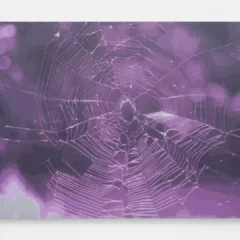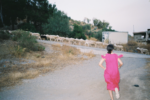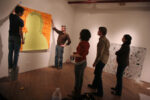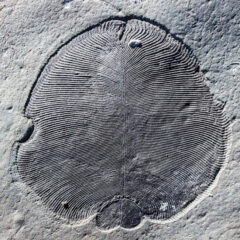“Ice Water Flyswatter,” despite its poetic pun of a title, won’t actually have a chilling effect on your interest in art. The exhibition, a collection of nine summer-themed artworks up now at Tiger Strikes Asteroid, shows a cold and calculated mastery of certain artistic forms, while also offering a ‘hot’ selection of abstract art. The latter includes works reminiscent of Frank Stella, Claes Oldenburg and Henri Matisse. Curated by Philadelphian Douglas Witmer, this show is both an exploration of the thrilling design elements present in abstract visual work and a unique portal through which to examine the themes and concerns implicit in contemporary abstract art.
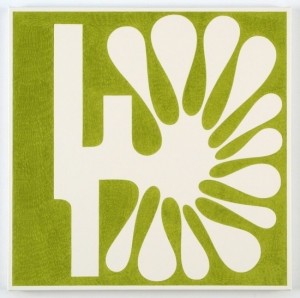
Cary Smith’s Splat #25 (green) is not just a “splat” – an onomatopoeic word that captures in its sound the meaning of a senseless, un-examined, un-planned dollop of paint being flung at a canvas. This contradictory title is an early warning sign that we are in the territory of a playful artist. The viewer’s eye is promptly drawn to the negative white space in Splat, which is seductively curvaceous with the air of a decoupage by Matisse. The deceptively-simple green background actually teems with tiny, living brushstrokes.
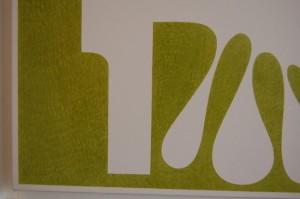
This use of detailed small spaces for explorations of play and color is also present in the works of Belgian artist Alain Biltereyst. His two geometric pieces, dwarfed by a swooping swath of orange paint from a work nearby, are edged into the corner of the gallery by the window, which cast an angular ray of light on them during my visit. They seem to fit into one another — one occupying the negative space that the other leaves behind – in an elegant and non-literal way. Looking closely, you notice that there is an element of ruggedness in their apparent austerity. In profile, the structure of the panel becomes clear, revealing a notched design of holes within the wood.
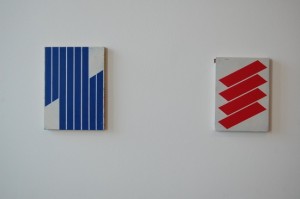
Continuing with the geometric theme is Paige Williams’s Hardly Noticed, which at first glance resembles a dull two-dimensional design study. But the slightly off-center median tilts the entire composition askew. The piece’s title applies to this puzzling and almost comical sleight of hand by which the Ohio-based artist activates several rectangular color bars around a wobbly center of gravity. From that point on, the viewer’s eye spirals outwards, taking in the various colors and their uniquely-intertwined earth and flesh tones.
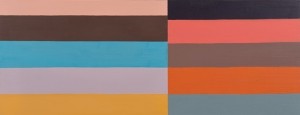
The largest and most eye-catching artwork in the show is a portrayal of the painting process, examined on a microscopic level. Yukpa by Donald Martiny breaks the boundary between painting and sculpture by depicting two projecting swathes of paint produced by a giant brush. On a canvas, this piece would impress viewers with its self-indulgence – just two brush-strokes of a single shade of yellow-orange. But in gigantic form, with every ridge and wave of the smeared paint’s texture visible, the work takes on the three-dimensional presence of an organism, physically crawling up the wall.
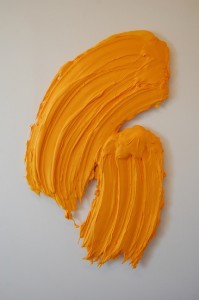
Not to be taken for a reference to the phallic Woody Woodpecker-inspired Oldenburg paintbrush that penetrates Broad Street, Martiny’s tongue-in-cheek paint swath is less of an aggressive statement and more a playful wink, a shape the piece resembles. A vague and unserious commentary on minimalism, both literal and figurative, Yukpa nudges the viewer out of the complementary color-induced trance that Ice Water Flyswater can bring on.
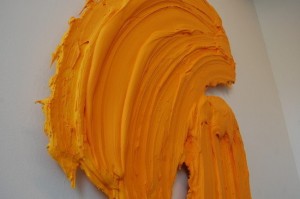
Mary Bucci McCoy’s And (not shown), an acrylic on panel, hangs between the gallery’s windows and hovers on the edge of visibility, with a misty quality akin to some of the paintings of Philadelphian, Thomas Chimes. Rounding out the show are pieces by Mark Wethli, and Ian White Williams.
While the show’s stated intent is to showcase artists rooted in “reductivism” who begin works with “cold-minded conceptual intentions” and take them to living, breathing places of color, fun and joy, it’s hard to put into words what is so pleasing and relaxing about it— the exhibit is like a glass of ice water on a hot August day. Perhaps it is the simple curatorial arrangement that makes “Ice Water Flyswatter” enjoyable: at the center of the room, the viewer will be greeted by a different color and visual effect from every direction. The fly swatter in a glass of water at the front of the gallery, in lieu of the show’s title being posted on the wall, indicates that this isn’t an exhibit meant to elicit furrowed brows and pained scrutiny. From the carefully proportioned compositions of Biltereyst and Williams to Martiny’s expansive, unconstrained brush-stroke-sculpture, this show takes viewers through a spectrum of visual explorations of color and order that will expand anyone’s aesthetic landscape. At times, however, some artists in the show hide themselves so skillfully that they might be at risk of disappearing.
“Ice Water Flyswatter” will be up at Tiger Strikes Asteroid through September 1.



